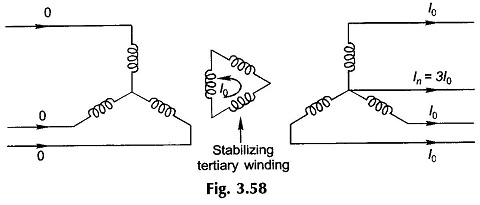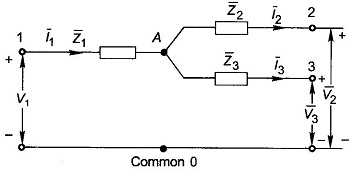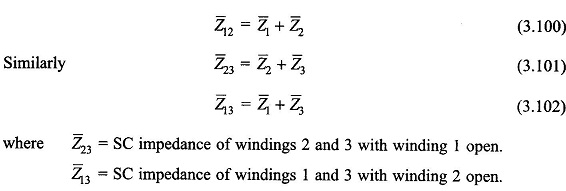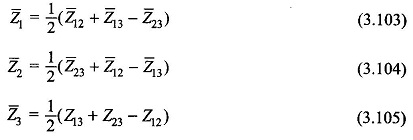Three Winding Transformer:
Three Winding Transformer may be built with a third winding, called the tertiary, in addition to the primary and secondary. Various purposes which dictate the use of a tertiary winding are enumerated below:
- To supply the substation auxiliaries at a voltage different from those of the primary and secondary windings.
- Static capacitors or synchronous condensers may be connected to the tertiary winding for reactive power injection into the system for voltage control.
- A delta-connected tertiary reduces the impedance offered to the zero sequence currents thereby allowing a larger earth-fault current to flow for proper operation of protective equipment. Further, it limits voltage imbalance when the load is unbalanced. It also permits the third harmonic current to flow thereby reducing third-harmonic voltages.
- Three windings may be used for interconnecting three transmission lines at different voltages.
- Tertiary can serve the purpose of measuring voltage of an HV testing transformer.
When used for purpose (iii) above the tertiary winding is called a stabilizing winding.
Stabilization by Tertiary Winding:
The star/star transformer comprising single-phase units or a single unit with a 5-limb core offers high reactance to the flow of unbalanced load between the line and neutral. Any unbalanced load can be divided into three 3-phase sets (positive, negative and zero sequence components). The zero-sequence component (cophasal currents on three lines, I0 = 1/3In) caused by a line-to-neutral load on the secondary side cannot be balanced by primary currents as the zero-sequence currents cannot flow in the isolated neutral star-connected primary.
The zero-sequence currents on the secondary side therefore set up magnetic flux in the core. Iron path is available for the zero sequence flux in a bank of single-phase units and in the 5-limb core and as a consequence the impedance offered to the zero-sequence currents is very high (0.5 to 5 pu) inhibiting the flow of these currents. The provision of a delta-connected tertiary permits the circulation of zero-sequence currents in it, thereby considerably reducing the zero-sequence impedance. This is illustrated in Fig. 3.58.
Equivalent Circuit:
The equivalent circuit of a Three Winding Transformers can be represented by the single-phase equivalent circuit of Fig. 3.59 wherein each winding is represented by its equivalent resistance and reactance. All the values are reduced to a common rating base and respective voltage bases.
The subscripts 1, 2 and 3 indicate the primary, secondary and tertiary respectively. For simplicity, the effect of the exciting current is ignored in the equivalent circuit. It may be noted that the load division between the secondary and tertiary is completely arbitrary. Three external circuits are connected between terminals 1, 2 and 3 respectively and the common terminal labelled 0. Since the exciting current is neglected, I1 + I2 + I3 = 0.
The impedance of Fig. 3.59 can be readily obtained from three simple short-circuit tests. If Z12 indicates the SC impedance of windings 1 and 2 with winding 3 open, then from the equivalent circuit,
All the impedances are referred to a common base.
Solving Eq. (3.100) to Eq. (3.102) yields
The open-circuit test can be performed on any one of the three windings to determine the core-loss, magnetizing impedance and turn-ratio.



